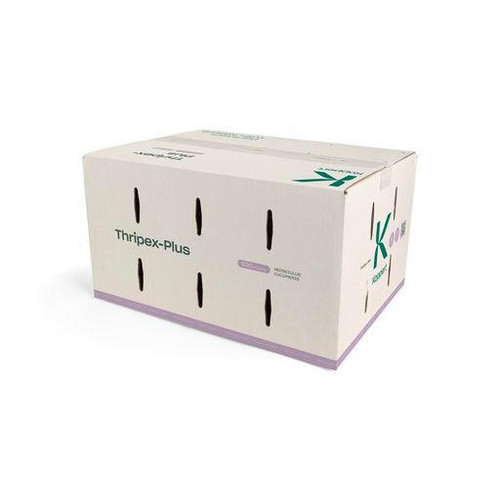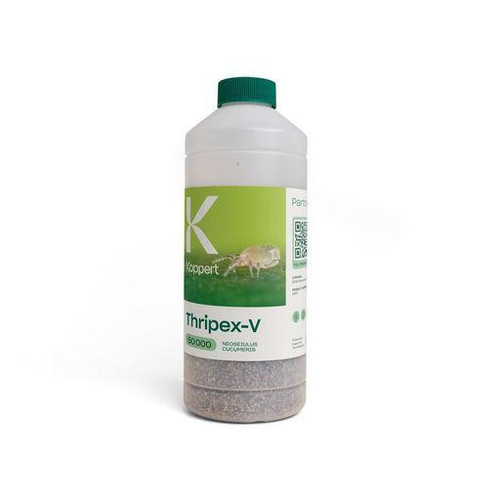Thripex Plus Sachets (Neoseiulus cucumeris) — Predatory Mite for Thrips and Mite Control
Thripex Plus sachets contain Neoseiulus cucumeris, a proven predatory mite for controlling thrips larvae and several mite species. PLUS sachets are designed for long-term, preventative coverage in crops with expected or recurring pressure from thrips or mites. Mites reproduce inside the sachet and disperse gradually into the crop over several weeks. Thripex Plus is chemical-free and safe for use in any growing environment including greenhouses, nurseries, orchards, flower beds, interiorscapes, outdoor landscapes, indoor plants including houseplants and more.
Use For
Thripex Plus targets young larvae of various thrips species, including:
Western flower thrips (Frankliniella occidentalis)
Onion thrips (Thrips tabaci)
Other greenhouse and ornamental thrips (e.g., Echinothrips americanus, Thrips fuscipennis, Thrips simplex)
As a Type III generalist, Neoseiulus cucumeris can also feed on:
Broad mites (Polyphagotarsonemus latus)
Cyclamen mites (Phytonemus pallidus)
Spider mites
*For dedicated spider mite control, we recommend Spical or Spidex
*For dedicated broad and russet mite control, we recommend Anso-Mite
When to Use Thripex Plus Sachets
Use wherever thrips or small mites are expected or present in crops with recurring pressure.
Recommended for:
Preventative coverage to stop thrips and mites before establishment
Early-stage pest presence
Hotspots requiring sustained biological control over several weeks
Plants with dense foliage or layered canopy structures where pests hide in leaf folds and undersides
Growers seeking long-term prevention & control
Curative Note:
Pair sachets with Thripex bulk bottles and/or Orius spp. for curative control. In the case of an active problem, sachets work in tandem with bottle formulations to provide long-lasting clean up and prevention against population resurgence. For tall plants or vertical hangers with an active problem, place sachets above and below the hotspot, apply bottles close to or directly at the problem. This dual strategy prevents pest spread and accelerates control.
How It Works
Mode of Action: Mites pierce and consume pest eggs and larvae using their mouthparts
Behavior: Mites reproduce inside the sachet and disperse gradually over several weeks, sachets produce multiple consecutive generations of predatory mites
Visual Effect: Pest populations decline as mites establish and feed
Release Duration: Several weeks depending on humidity and conditions
Sachet Type: PLUS paper-based sachet
Feeding Rates:
Nymphs and adults feed on thrips larvae and mite eggs
Adults and late-stage nymphs consume 1-5 prey items per day under optimal conditions
Feeding life stages last ~20 days, depending on temperature and prey availability
Lifecycle of Neoseiulus cucumeris
Egg Stage
Oblong, transparent white eggs laid on leaf hairs along veins
Hatch in 2–3 days under optimal conditions
Larval Stage
Non-feeding
Lasts 1–2 days
Nymphal Stages
Begins feeding
Highly mobile and effective in early suppression
Nymphal development lasts 4–6 days
Adult Stage
Actively hunts and consumes prey
Lifespan ~20 days
Capable of laying 2–3 eggs per day under optimal conditions
Release Rates & Placement
| Pressure Level | Rate per Plant | Repeat Interval |
|---|---|---|
| Preventative | 1 sachet | Every 4 weeks |
| Curative | 1–2 sachets (paired with bottles) | Every 3 weeks |
Placement Tips:
Hang sachets in sheltered spots, away from direct sun or heat
Hold by cardboard strip to avoid damage
Do not open sachets—exit hole is pre-made
Open shipping box near plants and tear sachets along perforations
Best Working Conditions
Temperature: Active from 59°F to 77°F; optimal range 68–77°F
Reproduction Peak: Fastest at 77°F
Humidity: Optimal at 70% RH or higher
Compatibility Guidance
Allow residues from oils or soaps to dry before application
Do not combine with other generalist predatory mites (Amblyseius swirskii, Amblydromalus limonicus, Transeius montdorensis, Amblyseius andersoni)
For pesticide/chemical compatibility details, check our Natural Enemies - Chemical Compatibility and Beneficial Insect & Pesticide Compatibility Table
Product Specifications
Species: Neoseiulus cucumeris
Pack Size: 500 sachets
Mite Count: 250 predatory mites + prey mites per sachet
Sachet Type: PLUS (paper-based)
Carrier: Bran
Presentation: Sachets in cardboard box
Appearance: White sachets with release hole; mites are beige and fast-moving; eggs are transparent white
Environmental Impact & Sustainability
Thripex Plus sachets support sustainable growing practices by replacing chemical sprays with natural predators. PLUS sachets reduce pesticide runoff, protect pollinators, and maintain ecological balance across growing environments.
What to Expect
Thripex Plus sachets release predators consistently after placement
Thrips and pest mites are suppressed as predators feed
Predators disperse through foliage for several weeks
Reapply based on scouting observations to maintain control and prevent resurgence
Recommended IPM Pairings
Horiver Yellow sticky traps for monitoring winged/adult thrips
Thripor for curative thrips control
Isarid Mycoinsecticide for knockdown in high-pressure zones
FAQs
Can I store this for later?
Long-term storage is not recommended. Apply promptly after receipt. Products ship fresh and may be refrigerated up to their expiration date, typically one month from shipping. Allow the product to reach room temperature before use. Holding past expiration reduces effectiveness and quality.
Does Thripex Plus contain adult mites?
Yes—sachets contain a mix of life stages, including adults, juveniles and eggs.
Is Thripex Plus safe for indoor plants?
Yes—completely safe for people, pets, and plants, making it ideal for use in enclosed environments like homes, offices, herb gardens and interiorscapes.
How soon will I see results?
Feeding starts immediately. Control builds quickly as predators move through affected areas.
Can I use this on tomatoes?
Yes, Thripex Plus is recommended for tomato crops. Tomatoes have natural resistances to certain predators, making it difficult for some predatory mites to maneuver and hunt on the plant. There is no harm to using Thripex in any set-up & Thripex is able to navigate tomatoes. For spider mite management in tomatoes, we recommend Spidex.
Does Thripex Plus feed on other pests?
Yes—Neoseiulus cucumeris feeds on thrips larvae, broad mites, and other small mites.
What is the difference between PLUS and Ulti-Mite sachets?
Ulti-Mite sachets are made from compostable film and tolerate humidity and temperature fluctuations. PLUS sachets are made from paper and should only be used in stable environments. Ulti-Mite is the preferred choice in most scenarios.











